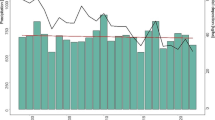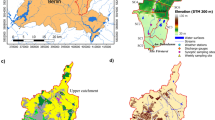Abstract
The adoption of pollution prevention and abatement practices is examined in the context of a model of exhaustible resource use with a backstop technology. For the sake of concreteness, the paper focuses on the problem of water-logging caused by the subsurface accumulation of agricultural drainwater. In modelling this problem, a region's underground capacity to store drainwater is considered an exhaustible resource, while the installation of subsurface drainage is viewed as the corresponding backstop technology (or abatement practice). The exhaustible resource is typically over-exploited due to common access problems, which forces a suboptimally fast adoption of the abatement practice. Conservationist irrigation technologies, such as drip and sprinkler systems, tend to reduce drainwater generation, and their adoption could increase social welfare by delaying the abatement stage. Public policies are suggested to increase the adoption of such conservationist technologies. Data from California is used to illustrate the results and to demonstrate the efficacy of the model for policy purposes. While the setting used for the analysis in this paper is quite specific (i.e., water-logging), the same general modelling ideas may be applied to many other problems of environmental degradation.
Similar content being viewed by others
References
Bryson, A. and Y. Ho (1975),Applied Optimal Control, Halsted Press, New York.
Caswell, M., E. Lichtenberg and D. Zilberman (1990), ‘The Effects of Pricing Policies on Water Conservation, Drainage Reduction, and the Adoption of New Irrigation Technologies’,American Journal of Agricultural Economics 72, 883–890.
Caswell, M. and D. Zilberman (1986), ‘The Effects of Well Depth and Land Quality on the Choice of Irrigation Technology’,American Journal of Agricultural Economics 68, 798–811.
Dasgupta, P. and G. Heal (1974), ‘The Optimal Depletion of Exhaustible Resources’,Review of Economic Studies 41, 3–28.
Dasgupta, P. and J. Stiglitz (1981), ‘Resource Depletion Under Technological Uncertainty’,Econometrica 49, 85–104.
Dinar, A., M. Campbell and D. Zilberman (1992), ‘Adoption of Improved Irrigation and Drainage Reduction Technologies under Limiting Environmental Conditions’,Environmental and Resource Economics 2, 373–398.
Dinar, A. and D. Zilberman, eds. (1991),The Economics and Management of Water and Drainage in Agriculture, Kluwer Academic Press, Boston.
Farzin, H. (1986),Competition in the Market for an Exhaustible Resource, JAI Press, Greenwich, Connecticut.
Hanemann, W. M., E. Lichtenberg, D. Zilberman, D. Chapman, L. Dixon, G. Ellis and J. Hukkinen (1987), ‘Economic Implications of Regulating Agricultural Drainage to the San Joaquin River’, Technical Committee Report, state Water Resources Control Board, Sacramento, California.
Hexem, R. and E. Heady (1978),Water Production Functions and Irrigated Agriculture, Iowa University Press, Ames, Iowa.
Hotelling, H. (1931), ‘The Economics of Exhaustible Resources’,Journal of Political Economy 39, 137–175.
Kamien, M. and N. Schwartz (1978), ‘Optimal Exhaustible Resource Depletion with Endogenous Technical Change’,Review of Economic Studies 45, 179–196.
Kim, D., M. Moore, J. Hancher and M. Nieswiadomy (1989), ‘A Dynamic Model of Adaptation to Resource Depletion: Theory and an Application to Groundwater Mining’,Journal of Environmental Economic and Management 17, 66–82.
Knapp, K., B. Stevens, J. Letey and J. Oster (1990), ‘A Dynamic Optimization Model for Irrigation Investment and Management Under Limited Drainage Conditions’,Water Resources Research 26, 1335–1343.
Peltzman, S. (1976), ‘Towards a More General Theory of Regulation’,Journal of Law and Economics 19, 211–240.
Rausser, G. and P. Zusman (1991), ‘Organizational Failure and the Political Economy of Water Resources Management’, in A. Dinar and D. Zilberman, eds.,The Economics and Management of Water and Drainage in Agriculture, Kluwer Academic Press, Boston.
Regev, U., H. Shalit and a. Gutierrez (1983), ‘On the Optimal Allocation of Pesticides with Increasing Resistance: The Case of the Alfalfa Weevil’,Journal of Environmental Economics and Management 10, 86–100.
Shah, F. and D. Zilberman (1991), ‘Government Policies to Improve Intertemporal Allocation of Water in Regions with Drainage Problems’, in A. Dinar and D. Zilberman, eds.,The Economics and Management of Water and Drainage in Agriculture, Kluwer Academic Press, Boston.
Weinberg, M., C. Kling and J. Wilen (1993), ‘Water Markets and Water Quality’,American Journal of Agricultural Economics 75, 278–291.
Author information
Authors and Affiliations
Additional information
The authors are grateful to Federico Castillo for research assistance; however, the responsibility for any errors or omissions in the paper rests solely with the authors. All correspondence relating to this manuscript should be addressed to Farhed Shah. Scientific Contribution No. 1583 of the Storrs Agricultural Experiment Station.
Rights and permissions
About this article
Cite this article
Shah, F., Zilberman, D. & Lichtenberg, E. Optimal combination of pollution prevention and abatement policies: The case of agricultural drainage. Environ Resource Econ 5, 29–49 (1995). https://doi.org/10.1007/BF00691908
Issue Date:
DOI: https://doi.org/10.1007/BF00691908




